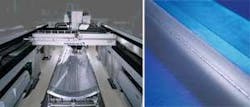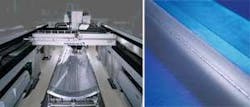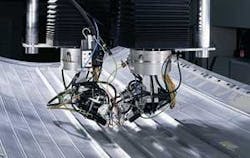Lighter in flight
Laser welding makes aircraft lighter
Ralf Möller
Laser welding of aircraft parts is a pioneering technology for the efficient manufacturing of weight-reduced, metal fuselage structures. The technique has been in use for three years at Airbus for serial production of the A318. Airbus has commissioned the Fraunhofer Institute for Material and Beam Technology (IWS-Dresden, Germany) to research the possibilities of optimizing the manufacturing process and to develop welding technologies for XXL aircraft structures. The main focus will be on the further development of two-sided-simultaneous laser welding, as well as on welding in areas with restricted access and the testing of new laser beam sources. The equipment supplied by Schuler Held Lasertechnik (Dietzenbach, Germany) will also be used to carry out research into the optimization of properties such as damage-tolerant construction methods, the reduction of distortion, the use of filler welding materials, and more meaningful results from destructive test procedures. IWS also acts as a test bed for Airbus with regard to systems technology, and in particular the actual laser welding line, as well as optical 3D seam monitoring and online detection of the seam’s flank angle.
Until recently, the overwhelming majority of all metal structural parts for aircraft were either riveted or bonded. However, ten years ago, Airbus began developing alternative joining techniques to riveting stringer panel connections. To raise the aircraft’s stability, these reinforcement elements are attached to various fuselage panels. In the laser welding process, the stringer is simultaneously welded on both sides to the panel with the use of filler wire. A roller clamping system is used to ensure exact positioning of the stringer.
Laser welding offers a number of benefits compared to riveting; allowing a simpler stringer design, the use of high-strength aluminum alloys rather than rivet alloys, and a reduction in the amount of sealing material required. This reduces weight significantly and improves the part’s corrosion behavior. The increased automation rate, the improvement in working speed by a factor of ten, and the reduction in material and logistic needs all result in a significant lowering of manufacturing costs.
With the aid of the Schuler Held system, which was put into operation in June last year, IWS is now working on enhancements to its production-ready process. The equipment enables IWS to undertake three-dimensional, two-sided, and simultaneous laser welding of stringers on extremely large and complex fuselage structures. The work area measures 10m × 3m × 1m, thus allowing the production of full-scale components. In order to achieve approximately the same beam parameters throughout the entire work area, the laser beam has to be widened by a factor of about 1.3. To this end, the line also features specially adapted telescopes, which first widen the beam and then reduce it again before entering the Z-axis.
To enable tests with both CO2 and Nd:YAG lasers, the line uses a Cartesian beam positioning system. The modular portal system consists of two side girders that bear the linear guides, the toothed racks, and the external measurement systems for the X-axis. Both aluminum Y bridges travel along these side girders and are positioned on both sides by rack-and-pinion drives to guarantee high positioning accuracy even with large bridge spans and heavy Z-axis constructions.
On both Y bridges, the three Z-axes also use linear guides, external measurement systems, and a rack-and-pinion drive. Two of the Z-axes each carry one laser welding head with the necessary positioning units for the A, B, and C axis. The third Z-axis carries the clamping device for positioning and guiding the stringer.
The Schuler Held system welds the stringer simultaneously along both sides with mechanically separated laser heads, which are mounted on the two independent Z-axes. This allows the two welding heads and accompanying clamping device to be moved individually or in sync along any 3D paths within the working area-which also permits counter-balancing movements in six axes, guaranteeing perfect weld seam positioning.
The decisive factor in ensuring seam quality is the ability to weld simultaneously and thus achieve an optimal stringer-panel connection. This minimizes material distortion and the formation of pores. At the same time, it ensures a homogeneous blending of the weld area with the additional material. This technically sophisticated process, in which both laser beams must meet, requires a highly accurate guidance system.
The flexible laser system is designed for two-sided, simultaneous welding of longitudinal stringers. With manual replacement of the laser head and clamping device the machine can also weld on struts set in a transverse direction (clips or ribs). To guarantee maximum flexibility, movements along the machine’s longitudinal axis (X-axis) are carried out by two independent Y bridges (separate parallel axes), which enables relative movement between laser beam and workpiece either through the separate transport of the Y bridges along the X-axis or the separate transport of the sliding table along the X-axis. It is also possible to move the Y bridges and sliding table in opposite directions along the X-axis simultaneously.
This combination of gantry machine with flying optic and sliding table guarantees the machine’s extreme flexibility. The movement of Y bridges and sliding table in opposite directions also results in greatly improved acceleration values and higher work speeds. Furthermore, it helps reduce the machine’s footprint.
The choice of a suitable laser beam source for the process and material is of particular importance. Because aluminum is highly reflective and heat conductive, laser sources that generate an extremely high beam quality are best suited for welding lightweight structures. The line therefore incorporates two Rofin-Sinar 4.5kW CO2 lasers.
Research results to date
Both laser types produce low-pore welding seams, free of hot cracks, which meet all quality requirements. Due to the lower energy of the CO2 laser compared to the Nd:YAG laser, the seam’s cross-sectional area is much smaller. However the tendency for pores to form is greater with the CO2 laser, while the tendency for hot cracks to form is lower. In the case of CO2 lasers and thin-walled stringers, the seam is generally convex, while Nd:YAG lasers form mainly concave seams. With regard to longitudinal distortion, it was noticed that the bulging created by the Nd:YAG laser was about twice as much as that of the CO2 laser. The same applies to the angular distortion on the panel side-creating an enhanced Zeppelin effect. Overall, the CO2 laser welding process runs much more smoothly and protecting the optics is therefore much easier.
IWS is also examining various methods for reducing distortion. Airbus currently uses tacking and subsequent shot peening treatment. The impact of hard particles on the surface creates residual stress and permanent deformation. The resulting compressive stresses in the forming area generally improve the part’s mechanical properties. An alternative is to “over bend” the panel in order to reduce the angular distortion, which is extremely complicated in the case of complex, spherically curved panels. Pre-heating the panel does prevent the real cause of the deformation-the differing thermal expansion of panel and stringer. To this end, IWS has developed a heated vacuum clamping table.
Welding reinforcement elements in a transverse direction (clips or ribs) requires very short seams. Due to the limited accessibility, however, conventional wire feeding is not possible. One solution developed by IWS for this problem is the prior depositing of tape material in the seam area.
During the entire project IWS and Schuler Held became a very creative project team. This was very important because the time frame of one year was extremely tight. Specification changes and other engineering decisions occured and modifications were even made during the construction phase. This is something that can’t be avoided in a totally new project of this kind. Both companies were always able to work together flexibly and in a spirit of trust.
Ralf Möller is sales and product manager for XXL Lasersystems with Schuler Held Lasertechnik GmbH & Co KG, Dietzenbach, Germany. He can be contacted by e-mail at [email protected].


